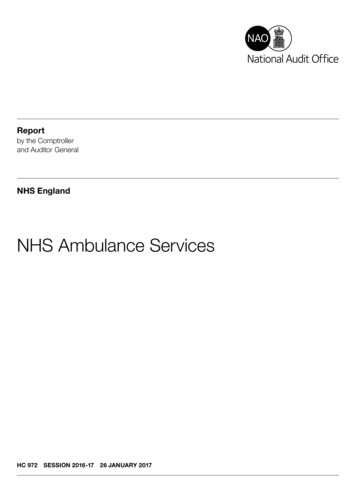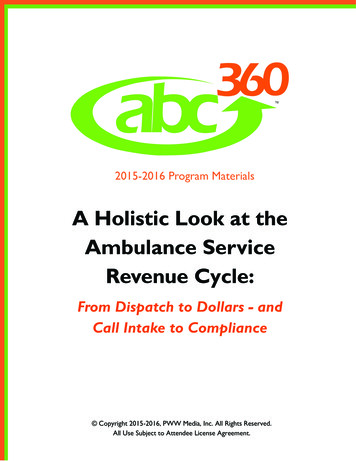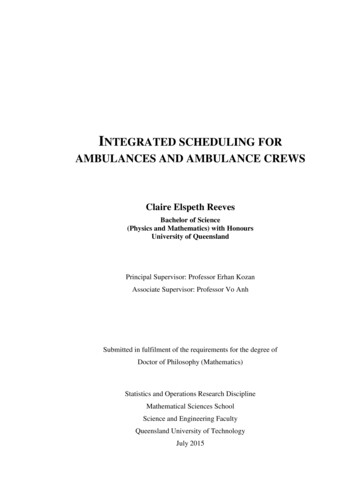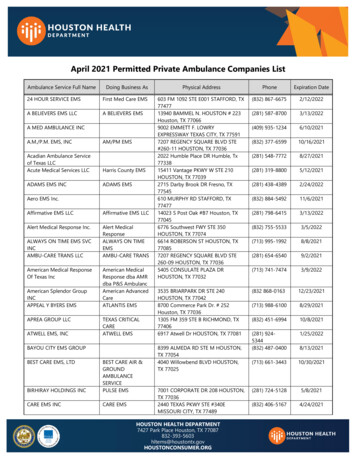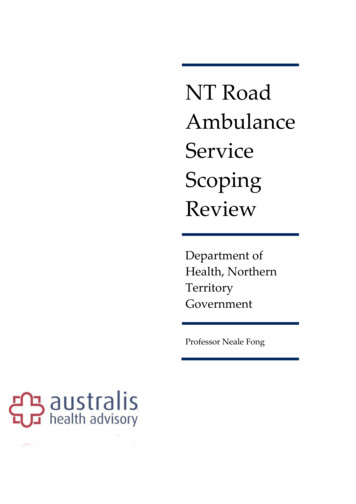
Transcription
Emergency Ambulance Services2022EVALUATION REPORTProgram Evaluation DivisionOffice of the Legislative AuditorState of Minnesota
Program Evaluation DivisionEvaluation StaffThe Program Evaluation Division was created withinthe Office of the Legislative Auditor (OLA) in 1975.The division’s mission, as set forth in law, is todetermine the degree to which state agencies andprograms are accomplishing their goals andobjectives and utilizing resources efficiently.Judy Randall, Legislative AuditorTopics for evaluations are approved by theLegislative Audit Commission (LAC), which hasequal representation from the House and Senate andthe two major political parties. However, evaluationsby the office are independently researched by theLegislative Auditor’s professional staff, and reportsare issued without prior review by the commission orany other legislators. Findings, conclusions, andrecommendations do not necessarily reflect the viewsof the LAC or any of its members.OLA also has a Financial Audit Division thatannually audits the financial statements of the Stateof Minnesota and, on a rotating schedule, audits stateagencies and various other entities. Financial auditsof local units of government are the responsibility ofthe State Auditor, an elected office established in theMinnesota Constitution.OLA also conducts special reviews in response toallegations and other concerns brought to theattention of the Legislative Auditor. The LegislativeAuditor conducts a preliminary assessment inresponse to each request for a special review anddecides what additional action will be taken by OLA.Caitlin BadgerGretchen BeckerEleanor BerryStephanie BesstSarah DelacuevaScott FuscoWill HarrisonDavid KirchnerKelly LehrLucas LockhartRyan MoltzJodi Munson RodríguezKaitlyn SchmaltzLaura SchwartzKatherine TheisenCaitlin Zanoni-WellsTo obtain reports in electronic ASCII text, Braille,large print, or audio, call 651-296-4708. People withhearing or speech disabilities may call throughMinnesota Relay by dialing 7-1-1 or 1-800-627-3529.To offer comments about our work or suggest anaudit, investigation, or evaluation, call 651-296-4708or e-mail legislative.auditor@state.mn.us.Printed on Recycled PaperFor more information about OLA and to access itsreports, go to: www.auditor.leg.state.mn.us.Photo provided by the Minnesota Department of Administration with recolorization done by 5811929076/in/album-72157663671520964/)Creative Commons License: ode
OL AOFFICE OF THE LEGISLATIVE AUDITORSTATE OF MINNESOTA Judy Randall, Legislative AuditorFebruary 2022Members of the Legislative Audit Commission:Minnesotans rely on ambulance services to provide care and transport when they experience amedical emergency. Hundreds of ambulance services around the state provide that care andtransport; they vary by organizational type and the level of care they provide. The EmergencyMedical Services Regulatory Board (EMSRB) is responsible for regulating ambulanceservices in Minnesota and supporting the overall emergency medical services system.In this report, we raise serious concerns about the regulation of ambulance services, theviability of some ambulance services, and EMSRB’s operations. Overall, EMSRB has beenineffective in its role as a systemwide leader on emergency medical issues and has failed toperform some of its basic responsibilities. We recommend that the Legislature and EMSRBtake action to address these and other issues.Our evaluation was conducted by David Kirchner (project manager), Gretchen Becker,Ryan Moltz, and Katherine Theisen. EMSRB board members and staff cooperated fully withour evaluation, and we thank them for their assistance.Sincerely,Judy RandallLegislative AuditorRoom 140 Centennial Building, 658 Cedar Street, St. Paul, Minnesota 55155-1603 Phone: 651-296-4708 Fax: 651-296-4712E-mail: legislative.auditor@state.mn.us Website: www.auditor.leg.state.mn.us Minnesota Relay: 1-800-627-3529 or 7-1-1
SummaryEmergency Ambulance ServicesThe Legislature should strengthen the state’s oversight of ambulanceservices and do more to support struggling services. The EmergencyMedical Services Regulatory Board (EMSRB) should improve its operations.Key Findings: In Fiscal Year 2021, more than 250 licensed ground ambulance services responded to approximately540,000 calls to 911 for medical emergencies in Minnesota. EMSRB is the state agency that regulatesambulance services in Minnesota. (pp. 3, 10) Each ground ambulance service license must be tied to a “primary service area,” the geographic area inwhich the ambulance service operates. EMSRB has little authority to alter primary service areaboundaries without the cooperation of the ambulance services assigned to them. (pp. 13, 19) Minnesota law does not provide meaningful oversight of ambulance services during the licenserenewal process. (p. 33) EMSRB has not used its existing authority to create performance standards for ambulance services.Further, it does not have authority to set standards for some key elements of practice. (pp. 40, 41) Ambulance services face persistent staffing and funding challenges across the state, but especially inoutstate Minnesota. (pp. 52, 56) EMSRB has been largely ineffective in its regulation and support of ambulance services in Minnesota,and the board has failed to provide sufficient oversight of the agency’s activities. EMSRB’s boardcomposition and unique responsibilities create risks for conflicts of interest. (pp. 62, 69, 73)Key Recommendations: The Legislature should retain primary service areas for ambulance services, but it should restructurehow they are created, modified, and overseen. (p. 24) The Legislature should adopt more stringent statutory requirements for renewal of ambulance servicelicenses. (p. 35) The Legislature should direct EMSRB to develop and enforce performance standards for ambulanceservices. (p. 48) The Legislature should explore options for improving ambulance service sustainability in Minnesota,potentially through pilot programs. (p. 59) The EMSRB board should improve its oversight of the executive director and ensure that theorganization fulfills its responsibilities and maintains adequate staff to do so. (p. 70) The Legislature should consider whether to make structural changes to the EMSRB board. It shouldalso clarify what constitutes a conflict of interest for EMSRB board members. (pp. 74, 76)OFFICE OF THE LEGISLATIVE AUDITOROL ARoom 140 Centennial Bldg.658 Cedar StreetSt. Paul, MN 55155-1603February .state.mn.usTel: 651-296-4708 Fax: 651-296-4712Minnesota Relay: 1-800-627-3529 or 7-1-1
S-2Report SummaryAmbulances are vehicles used to providetransportation for ill or injured persons or expectantmothers to, from, or between health care facilities.In Fiscal Year 2021, ground ambulances respondedto approximately 540,000 calls to 911. Ambulanceservices are the organizations that send ambulancesand crews to respond to emergencies. Ambulanceservices in Minnesota are operated by localgovernments, tribes, health care systems, or privateorganizations.The Emergency Medical Services RegulatoryBoard (EMSRB) is responsible for regulatingambulance services in Minnesota. As of July 2021,there were 277 ambulance services licensed tooperate in Minnesota.State statutes recognize two levels of health careprovided by ambulance services: basic life support(BLS) and advanced life support (ALS). BLS careinvolves basic emergency care and administrationof a limited number of drugs. It is generallyprovided by emergency medical technicians.ALS care can include additional treatments andprocedures, such as narcotic medications oradvanced heart monitoring. It is generally providedby paramedics.EMSRB has little authority to alter serviceboundaries without the cooperation of theambulance services assigned to them.Minnesota is divided into more than 250 “primaryservice areas,” the geographic areas in whichlicensed ambulance services have the right toprovide care and transportation. Within areaboundaries, the licensee must ensure 24-hourcoverage every day of the year. An ambulanceservice may not deny ambulance care to anyonewithin the service area based upon the individual’sability to pay.Once an ambulance service obtains a license for aprimary service area, it retains the right to provideservice in that area as long as it maintains itslicense. There are no provisions in state law forEMSRB to alter primary service area boundarieswithout the consent of the license holder, even ifEMSRB finds a public health benefit to doing so.Emergency Ambulance ServicesThe extent of local government controlover who provides ambulance service ina community depends on historicalprecedent.Whether a local unit of government controls itsambulance service provider depends largely onwhat entity ran an ambulance service in thatgovernmental unit’s area in the early 1980s.As a result, there are disparities in local controlthroughout the state. Local governments that donot already control ambulance provision in theircommunities have no easy way of gaining control.Conversely, once a licensee obtains control of aservice area, it is straightforward for the licensee tomaintain control.We recommend that the Legislature retain primaryservice areas. However, it should restructure howthey are created, modified, and overseen. TheLegislature should create a process for periodicallyreviewing service area boundaries and empowerEMSRB to redraw boundaries to address overlapsand gaps. The Legislature should also establish aprocess through which local units of governmentcan provide input into which service providesambulance care and transportation in their areas.Minnesota law does not providemeaningful oversight of ambulanceservices during the license renewalprocess.The process by which an ambulance service obtainsits initial license provides an opportunity for publicinput and state oversight. However, once anambulance service obtains a license, renewal ispractically automatic. Statutes do not requireEMSRB to inspect an ambulance service or assessits performance in any way as a condition ofapproving a renewal application.Even though the law’s requirements are minimal,EMSRB has not collected all required informationduring the renewal process for ambulance servicelicenses. We recommend that the Legislature adoptmore stringent statutory requirements forambulance service license renewal, and thatEMSRB ensure that ambulance services meetrequirements in law.
SummaryEMSRB has limited authority to overseeambulance service license transfers andchanges in service providers.Ambulance services can transfer their licenses toother entities through merger or acquisition; entitiesreceiving licenses in this way do not have to gothrough the initial licensure process. Statutes donot require EMSRB to conduct onsite inspectionsor otherwise ensure that license transfers will notnegatively affect public health. EMSRB typicallyasks the new licensee to simply attest that it meetslegal requirements.In some instances, the license holder is differentfrom the provider that runs the ambulance service.Statutes do not require license holders to notifyEMSRB or local governments if they discontinueproviding care and instead contract with an externalprovider, or if the license holder terminates acontract with one provider and enters into a contractwith another provider. Statutes also do not providea mechanism through which EMSRB could ensurethat the new provider meets legal requirementsbefore it begins providing service.We recommend that the Legislature requireambulance services to go through the initiallicensure process—a process that provides anopportunity for stronger public input and stateoversight—whenever there is a change inownership or provider.Minnesota has no standards forambulance services related to actualoutcomes.Minnesota ambulance laws require ambulanceservices to meet a number of standards in order toobtain a license. For example, ambulance crewsmust have a minimum level of training, andambulances must carry certain equipment, such asoxygen and defibrillators.However, all of these standards relate only to anambulance service’s resources and abilities;Minnesota has no standards related to actualoutcomes. For example, there are no performancestandards or targets for whether ambulance serviceshave provided appropriate care to patients withdifficulty breathing. If a service has not providedsufficient care, it is up to the service itself toidentify that a problem exists and address it.S-3EMSRB has not adopted performance standardseven though it has the authority to do so as arulemaking agency. However, for some keyelements of ambulance practice (such as the speedof ambulance response), EMSRB’s authority to setstandards is limited.We recommend that the Legislature direct EMSRBto develop and enforce performance standards forambulance services. EMSRB should work with theLegislature to determine whether it needs additionalstatutory authority to set appropriate performancestandards.Ambulance services face persistentstaffing challenges across the state, butespecially in outstate Minnesota.Many ambulance service directors responding to asurvey we conducted were not confident theirservices will be able to meet the needs of theircommunities five years from now.Although ambulance services in all parts of thestate reported staffing challenges, staffing shortagesappeared to be more acute in outstate Minnesota.In response to our survey, 61 percent of outstateservice directors reported that during the previousmonth, they had difficulty staffing ambulance shiftsat the level needed to adequately respond to 911calls. Severe staffing shortages have sometimes ledambulance services to be unable to respond to callsfrom their primary service areas.Ambulance services with low numbers ofambulance runs may not receive enoughrevenue from billing patients to covertheir costs.Unlike fire and police services, ambulance servicestypically are not primarily supported by taxes;instead they bill the individuals who use their service.However, services with low numbers of ambulanceruns may have more difficulty covering the cost ofproviding continuous coverage than services withhigh numbers of ambulance runs. In addition, mostambulance service directors indicated that Medicareand Medicaid reimbursements are insufficient tocover costs. Services with revenue challengesinstead rely on local government funding orvolunteer ambulance personnel.We recommend that the Legislature explore optionsfor improving ambulance service sustainability inMinnesota, potentially through pilot programs.
S-4Emergency Ambulance ServicesEMSRB has been largely ineffective in itsregulation and support of ambulanceservices in Minnesota.EMSRB—composed of a 19-member governingboard, an executive director, and several staff—isthe primary entity in Minnesota responsible forensuring that ambulance care is delivered bylicensed ambulance services and certifiedpersonnel. In addition to its regulatoryresponsibilities, the Legislature also createdEMSRB to serve in a broad support role foremergency medical services in the state.However, EMSRB has been ineffective in its role asa systemwide leader on emergency medical issues.For example, EMSRB has not created orimplemented a statewide plan for emergency medicalservices and has taken limited action to addressstaffing and sustainability issues in Minnesota as awhole. Further, EMSRB has not updated emergencymedical services regulations to account for changesin technology and service provision.EMSRB has also failed to perform some of its basicresponsibilities. For example, an EMSRB staffperson told us that many complaints EMSRBreceived from about 2017 to 2020 were notinvestigated at the time, in part because EMSRBdid not have sufficient numbers of staff.The board has not adequately overseen the agency’soperations for some time. Although the board’spolicies indicate it must annually evaluate theperformance of the executive director, it has notconducted a performance appraisal in more thanfive years.EMSRB’s board composition and uniqueresponsibilities create risks for conflictsof interest.Although statutes require that EMSRB’s boardmembers represent a variety of interests, nearlytwo-thirds of the board’s voting members as ofSeptember 2021 had professional ties to ambulanceservices. Only 1 of the board’s 17 voting members(6 percent) must be a member of the general public.Further, unlike similar state boards, EMSRBregulates businesses. The relationships EMSRBboard members have to ambulance services cancreate an appearance of conflicts of interest.Statutes and board policies define conflicts ofinterest narrowly, and do not take into accountEMSRB’s unusual circumstances.We make a number of recommendations to theLegislature and EMSRB to improve EMSRB’soperations. Most notably, we recommend that theLegislature consider whether to make structuralchanges to the EMSRB board. We also recommendthat the Legislature clarify what constitutes aconflict of interest for EMSRB board members.Summary of Agency ResponseIn a letter dated February 18, 2022, Emergency Medical Services Regulatory Board ExecutiveDirector Dylan Ferguson and Board Chair J.B. Guiton wrote that the evaluation report “raisesseveral serious and important issues” and described efforts the agency has undertaken in recentmonths to address the concerns presented in the report. Although stating that “We are pleasedwith the early progress” of the agency, they acknowledged that “significant work remains” andcalled for further “swift and appropriate actions” from emergency medical services providers,policymakers, and regulators. They stated that EMSRB is “committed to working diligently andcollaboratively with a broad range of stakeholders, including the Minnesota Legislature, tocontinue the process in implementing recommendations contained within this report.”The full evaluation report, Emergency Ambulance Services, is available at 651-296-4708 htm
Table of Contents1Introduction3Chapter 1: Background310Ambulance Services in MinnesotaState Regulation13Chapter 2: Primary Service Areas13172124PurposeLimits on Regulatory AuthorityImplications for Local ControlRecommendations27Chapter 3: Ambulance Service Licensure2731License Types and StructureLicensure Process39Chapter 4: Accountability394447StandardsMedical Oversight of Ambulance CareRecommendations51Chapter 5: Ambulance Service pter 6: EMSRB6167697176Systemwide LeadershipEMSRB OperationsBoard OversightBoard MembershipInconsistent Statutes79List of Recommendations81Appendix: Primary Service Area Maps91Agency Response
List of ExhibitsChapter 1: Background81.1 Several health care systems run ambulance services in multiple service areas.Chapter 2: Primary Service Areas182.1 Some parts of the state—such as the area around Rochester—have manyoverlapping primary service areas.Chapter 3: Ambulance Service Licensure293.1 Different areas of Minnesota are covered by different levels of ambulancecare.
IntroductionMinnesotans rely on ambulance services to provide emergency health care andtransportation to or between hospitals. Although these services are availablethroughout the state, differences exist—particularly between sparsely and more heavilypopulated areas—in terms of the level of care provided, the amount of control localgovernments can exert over ambulance services, and the ability of ambulance servicesto financially sustain themselves.In June 2021, the Legislative Audit Commission directed the Office of the LegislativeAuditor to evaluate emergency ambulance services. Our evaluation addressed thefollowing questions: To what extent do all Minnesotans have adequate and equitable access toambulance care and transportation? Does the Emergency Medical Services Regulatory Board (EMSRB) provideadequate oversight and governance of the state’s ambulance services?To answer these questions, we examined statutes and rules related to ambulanceservices, and conducted several interviews with EMSRB staff and board members.We also spoke with staff from the departments of Health, Human Services, and PublicSafety and representatives from regional emergency medical service organizations.Additionally, we spoke with representatives of the Minnesota Ambulance Association,Minnesota Rural Health Association, and the League of Minnesota Cities.To gain local perspectives, we interviewed ambulance service directors, medicaldirectors, and other administrators from nine ambulance services: Arlington AreaAmbulance Service, CentraCare Emergency Medical Services (Redwood Falls),Hennepin EMS (Minneapolis), Nashwauk Ambulance Service, North MemorialAmbulance Service (Brooklyn Center), Ridgeview Ambulance Service (Gaylord andWaconia), Ringdahl Ambulance (Fergus Falls), Tri-County EMS District (Karlstad),and White Bear Lake Fire Department. In several of these locations, we alsointerviewed one or more local stakeholders, such as administrators of county 911dispatch centers, fire departments, police departments, and hospitals. We also surveyedthe directors of all 258 ground ambulance services licensed to respond to 911 calls inMinnesota as of August 2021. We received responses from 186 directors, for aresponse rate of 72 percent.We analyzed several different types of data from EMSRB. The Minnesota StateAmbulance Reporting (MNSTAR) data system provides data on each event (or “run”)involving an ambulance response. The eLicense system provides data on ambulanceservices’ licenses and the certifications of individual emergency medical techniciansand paramedics. Lastly, we obtained records of the boundaries of the areas served byeach ambulance service, converted those records into geographic information systemsdata, and produced the maps which appear in the Appendix.
2Emergency Ambulance ServicesWe examined a variety of EMSRB documents, including board minutes and licenseapplications from the two most recent fiscal years. We also reviewed EMSRB’sinternal policies and procedures.Finally, we spoke with officials from ambulance regulatory agencies in four otherstates—Massachusetts, Michigan, Pennsylvania, and Wisconsin—to understandsimilarities and differences with Minnesota’s regulatory structure.1We restricted the scope of our evaluation to ground ambulance services and did notevaluate broader emergency medical services, such as the operation of 911 dispatchcenters, the provision of initial care by first responders like police and firefighters, orthe support provided by regional emergency medical services organizations. We alsodid not evaluate air ambulance services or community paramedicine programs.Our report spans six chapters. Chapter 1 presents key background information.Chapter 2 discusses “primary service areas,” the geographic areas that ambulanceservices are licensed to serve. Chapter 3 examines EMSRB’s licensing activities relatedto ambulance services. Chapter 4 discusses the mechanisms by and the extent to whichambulance services are subject to accountability. Chapter 5 is about the challenges thatsome ambulance services face with respect to sustainability. And Chapter 6 is aboutEMSRB’s effectiveness as an agency.1We selected states similar to Minnesota in the proportions of uninsured or publicly insured residents,the number of primary care providers compared to population needs, the number of 911 calls per100,000 residents, and range of driving distances to hospitals. Of the six state agencies we contacted foran interview, four agreed.
Chapter 1: BackgroundIn any location in Minnesota, a person experiencing a medical emergency can call911 and request that an ambulance be dispatched to their location. Approximately540,000 ambulance trips of this type took place in Minnesota in Fiscal Year 2021.Individuals call ambulances to respond to a wide range of medical emergencies,including falls, burns, abdominal pain, cardiac arrests, strokes, and depression.Ambulances also transport patientsbetween health care facilities, such asKey Findings in This Chapterfrom the emergency department at ahospital near the patient’s home to a Ambulance services combine bothmore distant hospital that offerspublic safety and health care functions.specialized care that the patient needs.Despite the availability of emergencyambulance services across the state,there is considerable variation in howthose services are organized, operated,and financed. In this chapter, weprovide an overview of the major typesof ambulance services, their structure,and the laws that regulate them. Persons with the same medicalconditions receive different care basedon where they are when they need anambulance. Some ambulance services rely heavilyor entirely on volunteers to staff theirambulances.Ambulance Services in MinnesotaAmbulances are vehicles used to provide transportation for ill or injured persons orexpectant mothers to, from, or between health care facilities.1 Ambulance services, aswe use the term throughout this evaluation, are the organizations that send ambulancesand crews to respond to emergencies.2 As of July 2021, there were 277 ambulanceservices licensed in Minnesota. The state licenses ambulance services to ensure thatthey meet certain requirements. We discuss the licensing process in Chapter 3.The state also registers or certifies several categories of ambulance service personnel.As described in the box on the next page, the categories represent different levels ofexpertise in patient care. Emergency medical responders (EMRs) are individuals whomay perform basic emergency care either before the arrival of a licensed ambulanceservice or when assisting an ambulance crew member with a higher certification.As of July 2021, there were approximately 16,000 registered EMRs in Minnesota.Emergency medical technicians (EMTs) and paramedics are the key providers of patientcare when an ambulance responds to a call. State certification in either category1Minnesota Statutes 2021, 144E.001, subds. 2 and 3.The statutory definition of “ambulance service” is “transportation and treatment which is rendered oroffered to be rendered preliminary to or during transportation to, from, or between health care facilities forill or injured persons or expectant mothers” (Minnesota Statutes 2021, 144E.001, subd. 3). However,many statutes clearly intend that “ambulance service” refer to an organization. For example, “No publiclyor privately owned ambulance service shall be operated in the state unless its ambulance service personnelare certified ” (Minnesota Statutes 2021, 144E.101, subd. 1(a)).2
4Emergency Ambulance Servicesrequires completion of a course thatmeets standards set by theU.S. Department of Transportation.3As of July 2021, there wereapproximately 10,000 EMTs and3,400 paramedics certified in Minnesota.Individuals can be registered as EMRs orcertified as EMTs or paramedics withoutworking for an ambulance service. Forexample, all Minneapolis firefighters arecertified as EMTs, even though theMinneapolis Fire Department does notoperate an ambulance service.Types of Ambulance PersonnelLeast Emergency medical responderstraining (EMRs) are trained to recognizeimmediate life threats, provideoxygen delivery and cardiopulmonaryresuscitation, and control shock andbleeding.Emergency medical technicians(EMTs) can use basic devices toassist patients to breathe, provideautomatic defibrillation, andadminister basic medications.Ambulance services make severalParamedics can provide advancedcare, including insertion of breathingdifferent types of responses or “runs.”tubes, advanced heart monitoring,Most ambulance runs occur in responseMost and administration of intravenousto 911 calls. In Fiscal Year 2021,training medications.ground ambulances responded toapproximately 540,000 calls to 911;these responses accounted for about 79 percent of ground ambulance runs in Minnesota.Most of the remaining runs (about 112,000 ground ambulance runs, 16 percent of thetotal) that year were interfacility transports—that is, transfers of patients via ambulancefrom one health care facility to another.4 Facilities such as hospitals and nursing homescannot provide interfacility transports themselves without an ambulance service license.Role of Ambulance ServicesAmbulance care and transport is part of a larger category known as “emergency medicalservices.” This system includes not only ambulances, but communications andtransportation networks, hospitals, trauma centers, and fire and police departments.Ambulance services combine both public safety and health care functions.Like public safety organizations—such as fire and police departments—the generalpublic expects ambulance services to be available at all times at any location inresponse to 911 calls. Like other public safety services, ambulance care is available toall, regardless of income or place of residence. Another similarity is that ambulancecrews are expected to deal with sudden, unexpected crises that most members of thegeneral public are unprepared to handle.3Minnesota Statutes 2021, 144E.001, subds. 5c and 5e; and 144E.28, subd. 1. The Emergency MedicalServices Regulatory Board also certifies advanced EMTs, community EMTs, and community paramedics.Approximately 300 people held one of these other certifications in Minnesota as of July 2021.The remaining 5 percent were other miscellaneous runs, such as “standby” runs, when an ambulance ison site at a sporting event in case an athlete is injured.4
Background5As with fire and police departments,consumers do not choose whichambulance service responds to a911 call. In Minnesota, 911 calls aregenerally answered by staff who workfor county sheriffs’ offices.Dispatchers determine whiche
over who provides ambulance service in a community depends on historical precedent. Whether a local unit of government controls its ambulance service provider depends largely on what entity ran an ambulance service in that governmental unit's area in the early 1980s. As a result, there are disparities in local control throughout the state .
![MOH STANDARDS FOR EMERGENCY AMBULANCE SERVICE (2017) [Updated 21 Nov 2018]](/img/51/emergencyambulancestandards.jpg)
